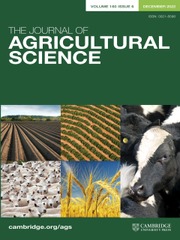Article contents
Insulin, prolactin and thyroxine responses to feeding, and to arginine and insulin injections during growth in lambs
Published online by Cambridge University Press: 27 March 2009
Summary
A study was made to determine the effects of feeding, arginine injection (0·5 g/kg live weight) and insulin injection (0·5 i.u./kg live weight) on plasma insulin, prolactin and glucose concentrations in ten growing castrated male lambs. The effect of feeding on thyroxine concentrations was also determined. Each test was performed once in each of four periods which commenced at 84, 98, 113 and 127 days of age respectively.
Feeding stimulated the release of insulin and this response was larger during period 4 than period 1. The release of prolactin following feeding did not change with age. Thyroxine concentrations, which were generally higher in periods 1 and 2 than 3 or 4, decreased from 1 to 12 h after feeding.
Arginine injection stimulated a similar insulin response in lambs of all ages but the prolactin release following arginine injection diminished with age.
Insulin injection caused marked hypoglycaemia in all periods, followed by dramatic increase in prolactin concentrations which increased with age.
Information
- Type
- Research Article
- Information
- Copyright
- Copyright © Cambridge University Press 1981
References
REFERENCES
- 9
- Cited by

